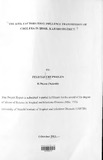| dc.contributor.author | Chepwogen, Felistas | |
| dc.date.accessioned | 2016-05-16T15:51:39Z | |
| dc.date.available | 2016-05-16T15:51:39Z | |
| dc.date.issued | 2011-10 | |
| dc.identifier.uri | http://hdl.handle.net/11295/95715 | |
| dc.description.abstract | Cholera remains a significant cause of morbidity and mortality in developing countries,
where it is a marker for inadequate drinking water and poor sanitation. Cholera outbreaks
have been a public health problem in some districts in Kenya including Kajiado district.
Cholera outbreak was reported in Kajiado district end of December 2009 affecting
various areas of the central district in which 255 cases and 4 deaths were reported.
Beginning January 2010, outbreaks of Cholera cumulatively affected 34 Districts
nationwide causing a total of 3235 cases and 63 deaths (CFR of 1.9%). In Kajiado
district, a total of 133 cases with 6 deaths (CFR=4.5%) were recorded up to mid 2010
with Bissil reporting the highest number of cases. Kajiado district is inhabited by the
Maasai community whose main occupation is pastoralism. Due to the frequent outbreaks
and high CFR, this study aimed at exploring whether there can be any community factors
that influence the transmission of cholera in the district.
Household level interviews guided by a structured questionnaire and focus group
discussions among community members revealed that despite high level of awareness
among the residents, a good proportion of over 40% were unable to describe the disease,
giving an indication of the likelihood of lacking knowledge. A third of the households
have ever experienced an episode of cholera and in most cases children were the most
affected. Dirty environment was blamed for the past cholera episodes in the households
and a many residents thought that flies and using unclean hands are risks to cholera
transmission. However, these findings show that there is a gap between knowing cholera
and being aware of factors that encourage transmissions. Latrine coverage is low
(40.8%); bushes around the homesteads were used by the majority of the household
members (55.5%) to dispose human waste. This practice has a direct influence to the state
of disease transmission in the area. This study found out that lack of safe drinking water,
lack of latrines and poor hygienic practices are possible risk factors for cholera
transmission in Bissil. In addition, the pastoralists’ lifestyle that involves movements
within the population is a likely factor that encourages easy transmission during
outbreaks. The risk factors described in this study that contribute to cholera outbreaks in
Bissil, Kajiado District will inform the policy makers in formulating strategies of
prevention and control of cholera in the area. | en_US |
| dc.language.iso | en | en_US |
| dc.rights | Attribution-NonCommercial-NoDerivs 3.0 United States | * |
| dc.rights.uri | http://creativecommons.org/licenses/by-nc-nd/3.0/us/ | * |
| dc.title | The risk factors that influence transmission of cholera in Bissil, Kajiado district. | en_US |
| dc.type | Thesis | en_US |
| dc.description.department | a
Department of Psychiatry, University of Nairobi, ; bDepartment of Mental Health, School of Medicine,
Moi University, Eldoret, Kenya | |



